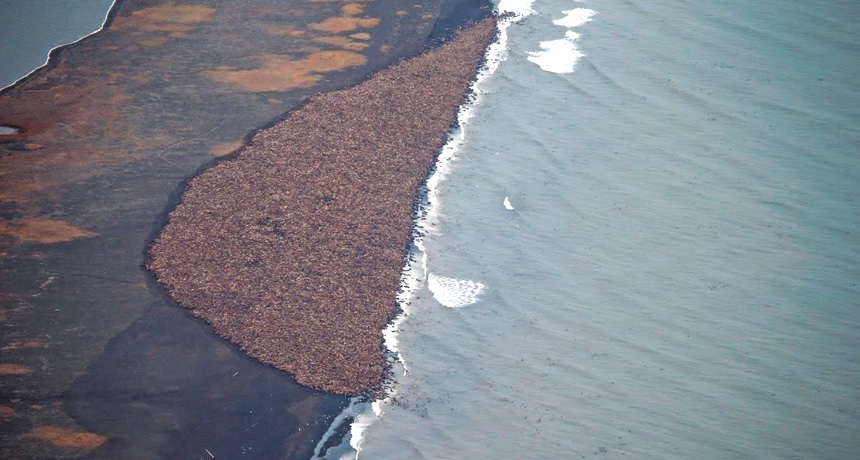Picture this: Too many walruses
A huge group of the animals has gathered on a beach near Point Lay, Alaska

A warming world means less sea ice. At this time of year, walruses usually rest on ice. But with no ice available, this group of walruses has been forced to haul out onto a beach.
Corey Accardo, NOAA Fisheries
That brown semi-circle in the middle of this picture is not a pile of pebbles. You’re looking at thousands of Pacific walruses. The huge herd recently hauled out onto this beach near Point Lay, Alaska. That’s a site on the state’s northwest Arctic coast across the Bering Strait from Russia.
Scientists first spotted the animals on September 13. At that time, researchers with the U.S. Fish and Wildlife Service estimated that nearly 10,000 of the animals had congregated. By September 27, this group — known as a haul out — had grown to more than 35,000 animals!
Majestic as the sight was, these walruses are not supposed to be on a beach at this time of year. During the summer and early fall, walruses usually live on ice. That’s because floating rafts of sea ice are closer to the animals’ feeding grounds than is the land. So the animals will haul out onto chunks of sea ice to rest between bouts of searching for food. Once rested, they dive back down to the shallow seafloor. There, walruses dine on mollusks, tube worms and other bottom-dwelling creatures.But the Arctic climate has been warming in recent years — more than anywhere else on Earth. That has resulted in less sea ice in the summer and fall. Without sea ice near their normal feeding grounds, walruses are forced to swim farther away from their food buffet and haul out on beaches when they need to rest. Instead of eating and sleeping close to where the food is — at floating oceanic hotels — they now must forage for food and then swim long distances to rest on land. This commuting takes energy. So the animals must eat more if they are to develop the large fat stores that will carry them through the harsh winter.
Scientists have spotted walrus haul outs on beaches in Alaska since 2007. This latest one has proven especially large.
A large haul out can be dangerous for walruses. Joel Garlich-Miller is a walrus expert with the U.S. Fish and Wildlife Service in Anchorage, Alaska. He says predators such as polar bears and people easily spook the herds. Loud noises also disturb them, such as the sound of a helicopter or low-flying plane. When frightened, walruses can stampede. In the chaos, smaller walruses, especially calves, may be trampled to death. The National Oceanographic and Atmospheric Administration, the U.S. Fish and Wildlife Service and local Alaskan communities are working to ensure no one disturbs these beach-dwelling walruses.
Power Words
Arctic A region that falls within the Arctic Circle. The edge of that circle is defined as the northernmost point at which the sun is visible on the northern winter solstice and the southernmost point at which the midnight sun can be seen on the northern summer solstice.
Arctic sea ice Ice that forms from seawater and that covers all or parts of the Arctic Ocean.
climate The weather conditions prevailing in an area in general or over a long period.
climate change Long-term, significant change in the climate of Earth. It can happen naturally or in response to human activities, including the burning of fossil fuels and clearing of forests.
forage To search for something, especially food.
mammal A warm-blooded animal distinguished by the possession of hair or fur, the secretion of milk by females for feeding the young, and (typically) the bearing of live young.
marine Having to do with the ocean world or environment.
National Oceanographic and Atmospheric Administration, or NOAA A science agency of the U.S. Department of Commerce. Initially established in 1807 under another name (The Survey of the Coast), this agency focuses on understanding and preserving ocean resources, including fisheries, protecting marine mammals (from seals to whales), studying the seafloor and probing the upper atmosphere.
mollusks Soft-bodied invertebrate animals that usually live in water and develop a hard protective shell. Examples include snails, shellfish (like clams and oysters), slugs, octopuses and squids.
predator (adjective: predatory) A creature that preys on other animals for most or all of its food.
U.S. Fish and Wildlife Service A research agency of the U.S. Department of the Interior, it was created in 1871 as the U.S. Commission on Fish and Fisheries. Fourteen years later, it acquired an office of ornithology (the science of birds). In 1905 it was renamed the Bureau of Biological Survey. It now has authority for research on and the conservation of land-based species, of freshwater species and of migratory birds.







